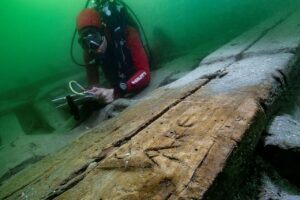In the wide world of whale sex, the largest of all species also ranks among the most private.
The intimate lives of the planet’s biggest animals range from eye-opening to relatable to hilarious. But of all cetacean species, we may know the least about the reproductive habits of blue whales.
At least now, we know where to look.
Marine biologists in Timor-Leste, a modest island situated along a major blue whale migration route between Australia and Indonesia, submitted the first underwater footage of a mother blue whale nursing a calf. The two animals are actually pygmy blue whales — a subgroup that’s several meters shorter than the species’ biggest individuals.
The Timor-Leste discovery, part of a 10-year study, could signal more groundbreaking insights to come.
“Our decade-long project has documented some of the lesser-known intimate reproductive behaviors of blue whales, some for the very first time,” said Karen Edyvane, marine ecologist and project lead on the Australian National University study. “From newborn calves and nursing mothers to amorous adults in courtship, the waters of Timor-Leste really are providing blue whale scientists with some of our first glimpses into the private lives of one of the world’s largest but most elusive animals.”
Like their parents, blue whale calves are enormous. Newborns average seven meters long and weigh in at 2,300-2,700 kilograms. They also grow rapidly, thanks in part to their mothers’ generous supply of high-fat milk. A new blue whale mother can produce 50 gallons of her 35-50% milk-fat lactate each day, according to the Marine Mammal Center. When a calf nurses healthily, it can gain an incredible 4.5 kg each hour.
None of that has helped scientists observe this or any other blue whale reproductive behavior, though. In 2018, scientists off the coast of Sri Lanka tracked two individuals performing a mating ritual for several days. The huge animals spend so much time feeding on krill, National Geographic explained, that “seeing other behaviors is quite rare.”
The ongoing effort to better understand these iconic, endangered whales could focus on Timor-Leste. Its deep coastal waters host famously prolific blue whale migrations each season along a 5,000km migration route. Whale tourism is popular on the island, and researchers identified it as one of the “most accessible and best” blue whale research locations.
As such, participatory citizen science fueled the success of Edyvane’s team. Research partner Jose Quintas, National Director for Environment and Research at the Timor-Leste Ministry of Tourism, said tourists, students, and anglers all shared information that drove the project forward.
As the project concludes, Quintas emphasized conservation as a key objective in the ongoing regional mission. The World Wildlife Fund estimates blue whale numbers at 10,000-25,000 — down from a pre-whaling population of 250,000 or more.
“We really need to use this valuable new information to ensure we fully protect and conserve these animals when they pass through Timor-Leste’s waters and beyond,” Quintas said. “For this, we urgently need cooperation and support from Australia and the wider international community.”
For the species to keep rebounding, it’s pivotal for young whales like the pygmy blue in the video to survive. Blue whales are thought to reproduce slowly — about once every two to three years.






